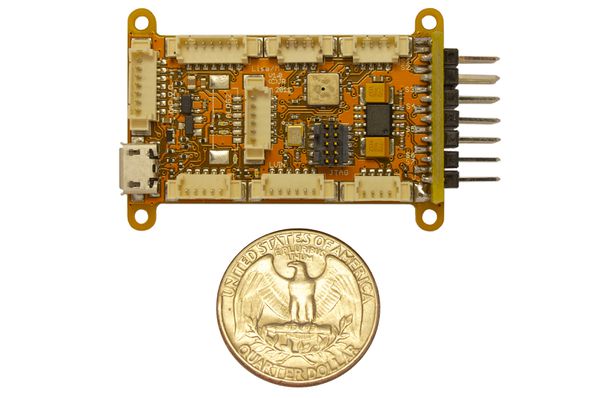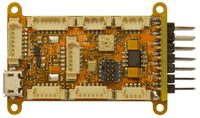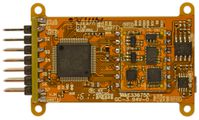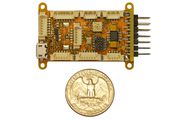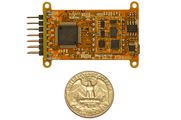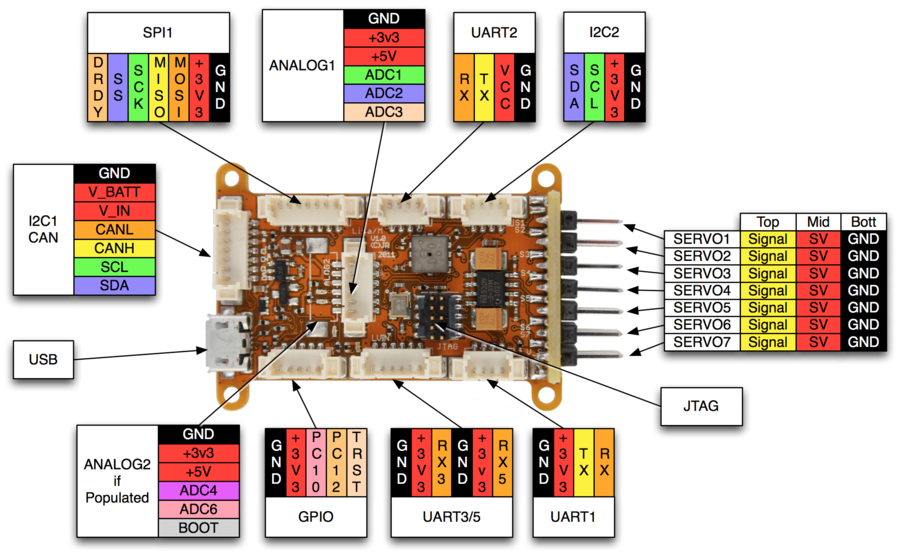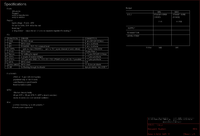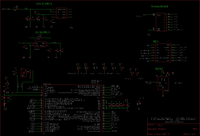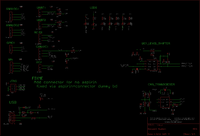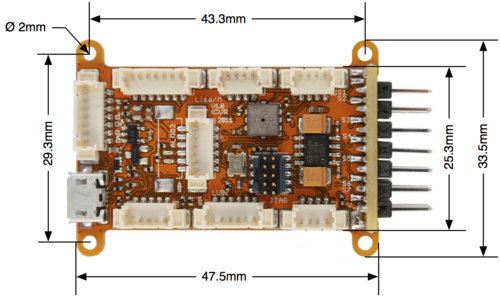Difference between revisions of "Lisa/M v1.0"
(Added pinout details, not finished, work in progress!!!) |
(Draft of new lisa/m docs following twog/umarim style, still missing significant details) |
||
| Line 10: | Line 10: | ||
!''Version #''!!''Release Date''!!''Release Notes'' | !''Version #''!!''Release Date''!!''Release Notes'' | ||
|- | |- | ||
|v1.0|| | |v1.0||MM/YYYY||Lisa/M Initial Production Release | ||
|- | |- | ||
|v0.1|| | |v0.1||MM/YYYY||Initial prototype of Lisa/M | ||
|} | |} | ||
For detailed hardware revision history, please [[Lisa/M#Detailed_Hardware_Revision_History | see below]]. | For detailed hardware revision history, please [[Lisa/M#Detailed_Hardware_Revision_History | see below]]. | ||
== Features == | == Features == | ||
Lisa/M is based on the 64 pins STM32F105RCT6 [http://www.st.com/internet/mcu/product/221023.jsp connectivity line family] processor featuring 64k of RAM and 256k of FLASH. All the pins are exposed, providing access to the complete set of the STM32 peripherals. | |||
NOTE: This MCU is different from LISA/L. Lisa/L is based on the 64 pins STM32F103RE processor featuring 64k of RAM and 512k of FLASH, which is part of the [http://www.st.com/internet/mcu/product/164485.jsp high-density performance line family]. | |||
* STM32 microcontroller [http://www.st.com/internet/com/TECHNICAL_RESOURCES/TECHNICAL_LITERATURE/DATASHEET/CD00220364.pdf STM32F105RCT6 datasheet] with 256kB flash and 64kB RAM | * STM32 microcontroller [http://www.st.com/internet/com/TECHNICAL_RESOURCES/TECHNICAL_LITERATURE/DATASHEET/CD00220364.pdf STM32F105RCT6 datasheet] with 256kB flash and 64kB RAM | ||
| Line 50: | Line 53: | ||
== Pinout == | == Pinout == | ||
Pins Name and Type are specified with respect to the Autopilot Board | Pins Name and Type are specified with respect to the Autopilot Board. | ||
[[Image:LisaM_V1_0_top_labeled.png|900px]] | [[Image:LisaM_V1_0_top_labeled.png|900px]] | ||
| Line 60: | Line 63: | ||
|1||SERVOx||OUT||Servo signal (PWM)||style="background:Yellow; color:black"|Yellow | |1||SERVOx||OUT||Servo signal (PWM)||style="background:Yellow; color:black"|Yellow | ||
|- | |- | ||
|2|| SV||PWR||Servo Voltage Rail||style="background:red; color:white"|Red | |2||SV||PWR||Servo Bus Voltage Rail||style="background:red; color:white"|Red | ||
|- | |- | ||
|3||GND||PWR||common ground||style="background:black; color:white"|Black | |3||GND||PWR||common ground||style="background:black; color:white"|Black | ||
| Line 80: | Line 83: | ||
|1||GND||PWR||common ground||style="background:black; color:white"|Black | |1||GND||PWR||common ground||style="background:black; color:white"|Black | ||
|- | |- | ||
|2|| | |2|| +3V3||PWR||UART Voltage (conf w/ JP6 and JP7)||style="background:Red; color:white"|Red | ||
|- | |- | ||
|3||TX||OUT||USART1 Serial Output (3.3V level)||style="background:Yellow; color:black"|Yellow | |3||TX||OUT||USART1 Serial Output (3.3V level)||style="background:Yellow; color:black"|Yellow | ||
| Line 154: | Line 157: | ||
|1||GND||PWR||common ground||style="background:black; color:white"|Black | |1||GND||PWR||common ground||style="background:black; color:white"|Black | ||
|- | |- | ||
|2|| V_BATT||PWR|| | |2|| V_BATT||PWR||V_BAT Bus on autopilot, voltage divider for V_BAT_MEAS, (use JP2 to connect to V_IN)||style="background:Red; color:white"|Red | ||
|- | |- | ||
|3|| V_IN||PWR|| | |3|| V_IN||PWR||Connected to autopilot voltage regulator inputs (conf w/ JP1, JP2 and JP3)||style="background:Red; color:white"|Red | ||
|- | |- | ||
|4||CANL||I/O||CANL||style="background:orange; color:white"|Orange | |4||CANL||I/O||CANL||style="background:orange; color:white"|Orange | ||
| Line 212: | Line 215: | ||
|1||GND||PWR||common ground||style="background:black; color:white"|Black | |1||GND||PWR||common ground||style="background:black; color:white"|Black | ||
|- | |- | ||
|2||VCC||PWR||UART Voltage||style="background:Red; color:white"|Red | |2||VCC||PWR||UART Voltage (conf w/ JP4 and JP5)||style="background:Red; color:white"|Red | ||
|- | |- | ||
|3||TX||OUT||USART2 Serial Output (3.3V level)||style="background:Yellow; color:black"|Yellow | |3||TX||OUT||USART2 Serial Output (3.3V level)||style="background:Yellow; color:black"|Yellow | ||
| Line 232: | Line 235: | ||
|4||SDA||I/O||SDA||style="background:blue; color:white"|Blue | |4||SDA||I/O||SDA||style="background:blue; color:white"|Blue | ||
|} | |} | ||
=== Jumper Configuration === | |||
There are a number of jumpers on Lisa/M used to configure voltage levels and power input. | |||
NEED TABLES AND DESCRIPTION OF JUMPER CONFIGURATION. | |||
=== Powering the Board === | |||
The 3.3V regulator on Lisa/M is a [http://www.micrel.com/page.do?page=/product-info/products/mic5209.shtml MIC5209-3.3YM] capable of sourcing up to 500mA. While it is possible to power this regulator with up to 16V, experience has shown that this regulator can become very hot in operation with high input voltages, resulting in potential thermal shutdown while in flight and likely a crash. Depending on the expected current draw, it is best to power this regulator with a lower voltage (5V has been fine). | |||
| Line 250: | Line 263: | ||
Need an Umarim V1.0-style ([[Umarim_v10#Large_Aircraft_Connection_Diagram | here]]) large aircraft airborne equipment electrical connections diagram here. | Need an Umarim V1.0-style ([[Umarim_v10#Large_Aircraft_Connection_Diagram | here]]) large aircraft airborne equipment electrical connections diagram here. | ||
<br style="clear:both"> | <br style="clear:both"> | ||
=== R/C Receivers === | |||
There is Spektrum parser available already, enabling the direct use of 1 or 2 Spektrum satellite receivers. | |||
Also UART pins can be used as general purpose I/O to be used for PPM input. Additionally [[PPM_Encoder | PPM encoder]] can be used to avoid receiver hardware modification. | |||
== PCB == | == PCB == | ||
| Line 267: | Line 286: | ||
=== Bill Of Material === | === Bill Of Material === | ||
'''''Download | '''''Download Lisa/M v1.0 Bill Of Material (zipped .xls file)''''' ''NOT YET AVAILABLE BUT SEE [[Lisa/M#Downloads|Downloads]]'' | ||
<br> | <br> | ||
<br> | <br> | ||
| Line 292: | Line 311: | ||
== Paparazzi USB Bootloader Upload == | == Paparazzi USB Bootloader Upload == | ||
There is currently not a bootloader for STM32-based autopilots. Work is underway to remedy this, see [https://github.com/paparazzi/luftboot Luftboot on GitHub]. Right now, one must use JTAG to load firmware to the board | There is currently not a bootloader for STM32-based autopilots. Work is underway to remedy this, see [https://github.com/paparazzi/luftboot Luftboot on GitHub]. Right now, one must use [[Lisa/M#JTAG|JTAG]] to load firmware to the board. | ||
=== Required components === | === Required components === | ||
| Line 301: | Line 320: | ||
=== Boot Sequence === | === Boot Sequence === | ||
== JTAG == | |||
JTAG can be used to upload firmware if no bootloader as present. It can also be used for debugging. | |||
* [[JTAG]] description; | |||
* General [[Dev/Debugging|debugging information]]; | |||
* [[DevGuide/JTAG-Debug|JTAG usage]], includes Eclipse uplink tutorial. | |||
== Detailed Hardware Revision History == | == Detailed Hardware Revision History == | ||
| Line 345: | Line 371: | ||
* REQ: Separate spot for external power if powered via separate battery. Realizing we can via Servo ports by Bridge J1 but still like to measure board voltage then and have a way to add power without mistakenly inject CAN Molex into SPI. | * REQ: Separate spot for external power if powered via separate battery. Realizing we can via Servo ports by Bridge J1 but still like to measure board voltage then and have a way to add power without mistakenly inject CAN Molex into SPI. | ||
[[Category:Lisa]] [[Category:User_Documentation]] | [[Category:Lisa]] [[Category:User_Documentation]] | ||
Revision as of 11:08, 8 March 2012
Lisa/M is a small, general purpose autopilot designed with flexibility across multiple applications in mind. Small weight and size, with (optional) integrated Aspirin IMU and full size 0.1" servo headers make the Lisa/M suitable for both fixed-wing and rotorcraft vehicles. This autopilot is based on the STM32 for improved peripherals and faster processing.
Hardware Revision History
| Version # | Release Date | Release Notes |
|---|---|---|
| v1.0 | MM/YYYY | Lisa/M Initial Production Release |
| v0.1 | MM/YYYY | Initial prototype of Lisa/M |
For detailed hardware revision history, please see below.
Features
Lisa/M is based on the 64 pins STM32F105RCT6 connectivity line family processor featuring 64k of RAM and 256k of FLASH. All the pins are exposed, providing access to the complete set of the STM32 peripherals. NOTE: This MCU is different from LISA/L. Lisa/L is based on the 64 pins STM32F103RE processor featuring 64k of RAM and 512k of FLASH, which is part of the high-density performance line family.
- STM32 microcontroller STM32F105RCT6 datasheet with 256kB flash and 64kB RAM
- Pressure sensor BMP085
- 7 x Analog input channels
- 3 x Generic digital in-/out-puts
- 2 x 3.3V TTL UART (5V tolerant)
- 7 x Servo PPM outputs
- 1 x CAN bus
- 1 x SPI bus
- 1 x I2C bus
- 1 x Micro USB
- 4 x status LEDs with attached test point
- 10.8 grams (0.4 oz) (with Aspirin IMU mounted)
- 9.9 grams (0.35 oz) (without Aspirin IMU mounted)
- ~33mm x ~56mm x ~10mm
- 4 layers PCB design
with mounted IMU has the following additional sensors on board:
- 3 Axis Gyroscope
- 3 Axis Accelerometer
- 3 Axis Magnetometer
The pressure sensor is mounted directly on the board as this sensor is not provided by Aspirin (v0.1 - v1.1). Except for a GPS unit you have all necessary sensors for full attitude and altitude stabilization in an extremely small package.
Pinout
Pins Name and Type are specified with respect to the Autopilot Board.
| Pin # | Name | Type | Description | Color |
|---|---|---|---|---|
| 1 | SERVOx | OUT | Servo signal (PWM) | Yellow |
| 2 | SV | PWR | Servo Bus Voltage Rail | Red |
| 3 | GND | PWR | common ground | Black |
| Pin # | Name | Type | Description | Color |
|---|---|---|---|---|
| 1 | N/A | N/A | JTAG Debug Header | None |
| Pin # | Name | Type | Description | Color |
|---|---|---|---|---|
| 1 | GND | PWR | common ground | Black |
| 2 | +3V3 | PWR | UART Voltage (conf w/ JP6 and JP7) | Red |
| 3 | TX | OUT | USART1 Serial Output (3.3V level) | Yellow |
| 4 | RX | IN | USART1 Serial Input (3.3V level, 5V Tolerant???) | Orange |
| Pin # | Name | Type | Description | Color |
|---|---|---|---|---|
| 1 | GND | PWR | common ground | Black |
| 2 | +3V3 | PWR | 3.3V Rail from autopilot | Red |
| 3 | RX3 | IN | USART3 Serial Input (3.3V level) | Orange |
| 4 | GND | PWR | common ground | Black |
| 5 | +3V3 | PWR | 3.3V Rail from autopilot | Red |
| 6 | RX5 | IN | USART5 Serial Input (3.3V level) | Orange |
| Pin # | Name | Type | Description | Color |
|---|---|---|---|---|
| 1 | GND | PWR | common ground | Black |
| 2 | +3V3 | PWR | 3.3V Rail from autopilot | Red |
| 3 | PC10 | I/O | GPIO PC10 | Pink |
| 4 | PC12 | I/O | GPIO PC12 | Dark Tan |
| 5 | TRST | I/O | JTAG_TRST | Light Tan |
| Pin # | Name | Type | Description | Color |
|---|---|---|---|---|
| 1 | GND | PWR | common ground | Black |
| 2 | +3V3 | PWR | 3.3V Rail from autopilot | Red |
| 3 | +5V | PWR | 5V Rail from autopilot | Red |
| 4 | ADC4 | I/O | ADC4 | Magenta |
| 5 | ADC6 | I/O | ADC6 | Pink |
| 6 | BOOT | I/O | BOOT | Grey |
| Pin # | Name | Type | Description | Color |
|---|---|---|---|---|
| 1 | N/A | N/A | USB | None |
| Pin # | Name | Type | Description | Color |
|---|---|---|---|---|
| 1 | GND | PWR | common ground | Black |
| 2 | V_BATT | PWR | V_BAT Bus on autopilot, voltage divider for V_BAT_MEAS, (use JP2 to connect to V_IN) | Red |
| 3 | V_IN | PWR | Connected to autopilot voltage regulator inputs (conf w/ JP1, JP2 and JP3) | Red |
| 4 | CANL | I/O | CANL | Orange |
| 5 | CANH | I/O | CANH | Yellow |
| 6 | SCL | I/O | SCL | Green |
| 7 | SDA | I/O | SDA | Blue |
| Pin # | Name | Type | Description | Color |
|---|---|---|---|---|
| 1 | GND | PWR | common ground | Black |
| 2 | +3V3 | PWR | 3.3V Rail from autopilot | Red |
| 3 | MOSI | Out | MOSI | Orange |
| 4 | MISO | In | MISO | Yellow |
| 5 | SCK | Out | SCK | Green |
| 6 | SS | Out | SS | Blue |
| 7 | DRDY | I/O | DRDY | Dark Tan |
| Pin # | Name | Type | Description | Color |
|---|---|---|---|---|
| 1 | GND | PWR | common ground | Black |
| 2 | +3V3 | PWR | 3.3V Rail from autopilot | Red |
| 3 | +5V | PWR | 5V Rail from autopilot | Red |
| 4 | ADC1 | In | ADC4 | Green |
| 5 | ADC2 | In | ADC6 | Blue |
| 6 | ADC3 | In | BOOT | Light Tan |
| Pin # | Name | Type | Description | Color |
|---|---|---|---|---|
| 1 | GND | PWR | common ground | Black |
| 2 | VCC | PWR | UART Voltage (conf w/ JP4 and JP5) | Red |
| 3 | TX | OUT | USART2 Serial Output (3.3V level) | Yellow |
| 4 | RX | IN | USART2 Serial Input (3.3V level, 5V Tolerant???) | Orange |
| Pin # | Name | Type | Description | Color |
|---|---|---|---|---|
| 1 | GND | PWR | common ground | Black |
| 2 | +3V3 | PWR | 3.3V Rail from autopilot | Red |
| 3 | SCL | I/O | SCL | Green |
| 4 | SDA | I/O | SDA | Blue |
Jumper Configuration
There are a number of jumpers on Lisa/M used to configure voltage levels and power input.
NEED TABLES AND DESCRIPTION OF JUMPER CONFIGURATION.
Powering the Board
The 3.3V regulator on Lisa/M is a MIC5209-3.3YM capable of sourcing up to 500mA. While it is possible to power this regulator with up to 16V, experience has shown that this regulator can become very hot in operation with high input voltages, resulting in potential thermal shutdown while in flight and likely a crash. Depending on the expected current draw, it is best to power this regulator with a lower voltage (5V has been fine).
Schematic
Examples of Airborne Equipment Electrical Connections
Small Aircraft Connection Diagram
Need an Umarim_v1.0-style ( here) small aircraft airborne equipment electrical connections here.
Large Aircraft Connection Diagram
Need an Umarim V1.0-style ( here) large aircraft airborne equipment electrical connections diagram here.
R/C Receivers
There is Spektrum parser available already, enabling the direct use of 1 or 2 Spektrum satellite receivers.
Also UART pins can be used as general purpose I/O to be used for PPM input. Additionally PPM encoder can be used to avoid receiver hardware modification.
PCB
Gerber & Drill Files
Download Lisa/M v1.0 gerber & drill files (zip) NOT YET AVAILABLE BUT SEE Downloads Need some generated gerbers and drill files here.
Assembly
Components Layout
NOT YET AVAILABLE BUT SEE Downloads Need some top and bottom of board images and line drawings here.
Bill Of Material
Download Lisa/M v1.0 Bill Of Material (zipped .xls file) NOT YET AVAILABLE BUT SEE Downloads
PCB and assembled boards suppliers
Available on Get Hardware page, hopefully :)
Mechanical Dimensions
Downloads
Source files
- download available on GitHub: Lisa/M v1.0 Cadsoft Eagle 6 Design
Gerber & Drill files
- download NOT YET AVAILABLE Need generated gerbers and drill files
Assembly files
- download NOT YET AVAILABLE Need Lisa/M v1.0 Components layouts (pdf)
- download NOT YET AVAILABLE Need Lisa/M v1.0 Bill Of Material
Paparazzi USB Bootloader Upload
There is currently not a bootloader for STM32-based autopilots. Work is underway to remedy this, see Luftboot on GitHub. Right now, one must use JTAG to load firmware to the board.
Required components
Connection Diagram
Boot Sequence
JTAG
JTAG can be used to upload firmware if no bootloader as present. It can also be used for debugging.
- JTAG description;
- General debugging information;
- JTAG usage, includes Eclipse uplink tutorial.
Detailed Hardware Revision History
Changes Between v1.1 and v2.0
- Lot's of silkscreen improvements
- Added attributes to all parts to make the usage of bom-ex ulp possible.
- Improved routing to allow teardropping
- Fixed stm32f1, f2 and f4 compatibility circuit. (has to jump to ground not to 3v3)
- Connected existing UART RX pullups to the respective connector power pins instead of 3v3. To prevent connecting 5V over IO pin to the 3v3 power rail.
- Added pullups on all UART RX lines to prevent undesired floatation.
- LED's are connected to 3v3 now. To make sure we don't have an issue with voltage tolerance on the gpio pins.
- ...
Changes Between v1.0 and v1.1
- Removed pull-ups on the USB gpio
- Removed pull-ups on the CAN gpio
- Connected usb_vbus to pa9 (needed by the USBotg)
- Removed USB pullup transistor as usbotg has a built in pullup
- Swapped UART1 with UART3 (uart1 was used for gps and pa9 was it's tx line, to be able to talk to the gps unit uart3 is a better choice, as uart1 only has an rx line now it is a better choice for spektrum RX modules)
- Removed USART3 TX gpio from the GPIO connector and moved to the GPS connector
- Added voltage selector jumpers to the RC RX connector; to enable powering of 3v3 or an 5v receivers
- Replaced vertical board solution with through hole servo pin headers (easier assembly)
- Servo connectors are in groups of two; for easier assembly
- Servo VBUS is connected together on all four layers; for lower resistance
- Moved LED's from under the analog2 connector; to be able to populate LED's and the connector
- Moved the RC RX connector a bit; to prevent crashing with the jtag plug
- Added one additional servo connector; now we have all 8 accessible through the standard servo connectors
- Fixed servo channel labeling to start at S0 as it is the case on TWOG and Tiny autopilot boards
- Added secondary through hole picoblade USB connector for easier routing of USB inside an airframe
- ...
Changes Between v0.1 and v1.0
- Switched to stm32f105 to be able to use usb and can at the same time
- Added alternative use of the adc lines as led output
- ...
Hardware Change Requests
- REQ: Replace BMP085 with MS5611 (the MS5611 seems to be better in performance then the BMP but it is more expensive and seems to be more difficult to obtain.
- A: This upgrade will be available through Aspirin v2.0 --Esden 22:54, 5 January 2012 (CET)
- REQ: Replace 7 Pin CAN with molex with something less risky to be inserted in 7 Pin SPI in relation to powering the board via CAN molex.
- REQ: Separate spot for external power if powered via separate battery. Realizing we can via Servo ports by Bridge J1 but still like to measure board voltage then and have a way to add power without mistakenly inject CAN Molex into SPI.
